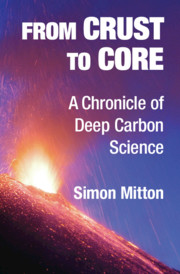Book contents
- From Crust to Core
- From Crust to Core
- Copyright page
- Dedication
- Contents
- Foreword
- Acknowledgments
- Introduction
- 1 Why Carbon in Earth Matters
- 2 The Origin of Deep Carbon in Deep Space
- 3 Deliveries of Cosmic Carbon Continue
- 4 On the Nature of Earth’s Interior
- 5 Earth’s Physical Interior Revealed
- 6 Thousands, Millions or Billions
- 7 Physics and Chemistry of Deep Earth
- 8 Confronting the Continental Drift Conundrum
- 9 The Mid-Atlantic Ridge and Rift Valley
- 10 Earth’s Deep Dynamics Discovered
- 11 Reversals of Fortune
- 12 Deep Carbon
- 13 Carbon-Bearing Phases in the Mantle
- 14 Diamond in the Mantle
- 15 Deep Life
- Glossary
- Biographical Notes
- Index
- References
5 - Earth’s Physical Interior Revealed
Published online by Cambridge University Press: 19 December 2020
- From Crust to Core
- From Crust to Core
- Copyright page
- Dedication
- Contents
- Foreword
- Acknowledgments
- Introduction
- 1 Why Carbon in Earth Matters
- 2 The Origin of Deep Carbon in Deep Space
- 3 Deliveries of Cosmic Carbon Continue
- 4 On the Nature of Earth’s Interior
- 5 Earth’s Physical Interior Revealed
- 6 Thousands, Millions or Billions
- 7 Physics and Chemistry of Deep Earth
- 8 Confronting the Continental Drift Conundrum
- 9 The Mid-Atlantic Ridge and Rift Valley
- 10 Earth’s Deep Dynamics Discovered
- 11 Reversals of Fortune
- 12 Deep Carbon
- 13 Carbon-Bearing Phases in the Mantle
- 14 Diamond in the Mantle
- 15 Deep Life
- Glossary
- Biographical Notes
- Index
- References
Summary
For many centuries, the search for concordances with ancient texts dominated the timeline of natural history, and there was no connection with geology. This scenario did not appeal to Robert Hooke (1635–1703) who, in 1662 at the age of 27, was appointed the curator of experiments at the Royal Society. He became a great polymath, Renaissance man and indeed a jack of all trades: architecture, astronomy, biology, mechanics, optics and geology came within his remit. His numerous inventions included the iris diaphragm, the universal joint and the compound microscope. He accumulated a huge personal fortune (£8000 in gold and cash, equivalent to a few million pounds today) when he and his friend Christopher Wren worked intensively in 1666–1680 as the principal architects rebuilding London after the Great Fire. Hooke’s career as curator at the Royal Society established his reputation as the first natural philosopher to focus on experiments made with precision instruments. For him, Nature was a great machine or engine in motion, the secrets of which could be uncovered with ingenious devices.
- Type
- Chapter
- Information
- From Crust to CoreA Chronicle of Deep Carbon Science, pp. 77 - 96Publisher: Cambridge University PressPrint publication year: 2020

